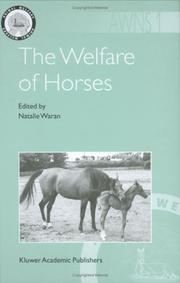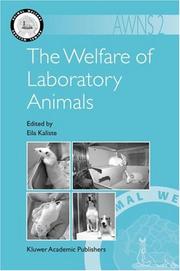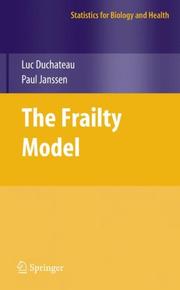| Listing 1 - 5 of 5 |
Sort by
|
Book
ISBN: 9789048136506 9789048136490 Year: 2010 Publisher: Dordrecht Springer Netherlands
Abstract | Keywords | Export | Availability | Bookmark
 Loading...
Loading...Choose an application
- Reference Manager
- EndNote
- RefWorks (Direct export to RefWorks)
Describes the welfare implications of keeping wild and domestic birds in captivity. The environmental and social requirements of various avian species are discussed and suggestions made for appropriate housing and management techniques. Particular attention is paid to human-bird interactions and their impact on the behavior and welfare of the birds involved. Training methods for companion birds are also described. Possible future trends in keeping birds in captivity are discussed in relation to evolving laws and codes for both wild and domesticated birds and in the light of developing attitudes to animals.
Life Sciences. --- Zoology. --- Animal Genetics and Genomics. --- Animal Physiology. --- Behavioural Sciences. --- Veterinary Medicine. --- Life sciences. --- Veterinary medicine. --- Animal behavior. --- Animal genetics. --- Sciences de la vie --- Médecine vétérinaire --- Animaux --- Zoologie --- Génétique animale --- Moeurs et comportement --- 590.2 --- dierenwelzijn (lt) --- vogels (lt) --- Animal welfare --- Aviculture --- Bird culture --- Birds --- Culture, Bird --- Rearing of birds --- Animal culture --- Abuse of animals --- Animal cruelty --- Animals --- Animals, Cruelty to --- Animals, Protection of --- Animals, Treatment of --- Cruelty to animals --- Humane treatment of animals --- Kindness to animals --- Mistreatment of animals --- Neglect of animals --- Prevention of cruelty to animals --- Protection of animals --- Treatment of animals --- Welfare, Animal --- Culture --- Husbandry --- Rearing --- Abuse of --- Social aspects

ISBN: 9781402007668 1402007663 9780306482151 1402061420 0306482150 1280957840 Year: 2007 Publisher: Dordrecht Springer
Abstract | Keywords | Export | Availability | Bookmark
 Loading...
Loading...Choose an application
- Reference Manager
- EndNote
- RefWorks (Direct export to RefWorks)
Animal welfare is attracting increasing interest worldwide, but particularly from those in developed countries, who now have the knowledge and resources to be able to offer the best management systems for their farm animals, as well as potentially being able to offer plentiful resources for companion, zoo and laboratory animals. The increased attention given to farm animal welfare in the West derives largely from the fact that the relentless pursuit of financial reward and efficiency has led to the development of intensive animal production systems, that challenge the conscience of many consumers in those countries. In developing countries human survival is still a daily uncertainty, so that provision for animal welfare has to be balanced against human welfare. Welfare is usually provided for only if it supports the output of the animal, be it food, work, clothing, sport or companionship. In reality, there are resources for all if they are properly husbanded in both developing and developed countries. The inequitable division of the world’s riches creates physical and psychological poverty for humans and animals alike in all sectors of the world. Livestock are the world’s biggest land user (FAO, 2002) and the population is increasing rapidly to meet the need of an expanding human population. Populations of farm animals managed by humans are therefore increasing worldwide, and there is the tendency to allocate fewer resources to each animal. Increased attention to welfare issues is just as evident for companion, laboratory, wild and zoo animals.
Horses. --- Animal welfare. --- Chevaux --- Animaux --- Protection --- Agriculture. --- Horses --- Animal welfare --- Recreation & Sports --- Zoology - General --- Zoology --- Social Sciences --- Health & Biological Sciences --- 633.5 --- Paarden (lt) --- Veterinary medicine --- Abuse of animals --- Animal cruelty --- Animals --- Animals, Cruelty to --- Animals, Protection of --- Animals, Treatment of --- Cruelty to animals --- Humane treatment of animals --- Kindness to animals --- Mistreatment of animals --- Neglect of animals --- Prevention of cruelty to animals --- Protection of animals --- Treatment of animals --- Welfare, Animal --- Equus caballus --- Farriery --- Hippology --- Horse --- Domestic animals --- Equus --- Livestock --- Pachyderms --- Hinnies --- Mules --- Abuse of --- Social aspects --- Zoology. --- Animal genetics. --- Animal physiology. --- Animal behavior. --- Animal Genetics and Genomics. --- Animal Physiology. --- Behavioral Sciences. --- Animals, Habits and behavior of --- Behavior, Animal --- Ethology --- Animal psychology --- Ethologists --- Psychology, Comparative --- Animal physiology --- Biology --- Anatomy --- Genetics --- Natural history --- Behavior --- Physiology --- Behavioral sciences.

ISBN: 9781402022708 1402022700 9781402022715 9781402061363 1402061366 9786610852390 1280852399 1402022719 Year: 2004 Volume: 2 Publisher: Dordrecht ; Boston : Kluwer Academic Publishers,
Abstract | Keywords | Export | Availability | Bookmark
 Loading...
Loading...Choose an application
- Reference Manager
- EndNote
- RefWorks (Direct export to RefWorks)
Animal welfare is attracting increasing interest worldwide, but particularly from those in developed countries, who now have the knowledge and resources to be able to offer the b est management systems for their farm animals, as well as potentially being able to offer plentiful resources for companion, zoo and laboratory animals. The increased attention given to animal welfare in the West derives la rgely from the fact that the relentless pursuit of financial reward and efficiency has lead to the development of intensive animal production systems that offend the conscience of many consumers in those countries. In devel oping countries, human survival is still a daily uncertainty, so that provision fo r animal welfare has to be balanced against human welfare. Welfare is usua lly provided for only if it supports the output of the animal, be it food, work, clothing, sport or companionship. In reality there are resources for all if they are properly husbanded in both developing and developed countries. The inequitable division of the world’s riches creates physical and psychological poverty for humans and animals alike in all sectors of the world. Liv estock are the world’s biggest land user (FAO, 2002) and the population, particularly of monogastric animals, is increasing rapidly to meet the need of an expanding human population. Populations of animals managed by humans are therefore increasing worldwide, so there is the tendency to allocate fewer resources to each one.
Animal Welfare. --- Animals, Laboratory. --- Animal welfare. --- Laboratory animals. --- Animaux --- Animaux de laboratoire --- Protection --- Agriculture. --- Laboratory animals --- Animal welfare --- Animal Welfare --- Animals, Laboratory --- Animal Population Groups --- Social Control, Formal --- Sociology --- Animals --- Social Sciences --- Eukaryota --- Anthropology, Education, Sociology and Social Phenomena --- Organisms --- Zoology - General --- Social Welfare & Social Work - General --- Animal Sciences --- Zoology --- Agriculture --- Social Welfare & Social Work --- Health & Biological Sciences --- Earth & Environmental Sciences --- Animals, Experimental --- Animals in research --- Experimental animals --- Lab animals --- Animal culture --- Laboratory organisms --- Working animals --- Animal experimentation --- Abuse of animals --- Animal cruelty --- Animals, Cruelty to --- Animals, Protection of --- Animals, Treatment of --- Cruelty to animals --- Humane treatment of animals --- Kindness to animals --- Mistreatment of animals --- Neglect of animals --- Prevention of cruelty to animals --- Protection of animals --- Treatment of animals --- Welfare, Animal --- Abuse of --- Social aspects --- Zoology. --- Animal genetics. --- Animal behavior. --- Animal physiology. --- Veterinary medicine. --- Animal Genetics and Genomics. --- Behavioral Sciences. --- Animal Physiology. --- Veterinary Medicine/Veterinary Science. --- Farriery --- Large animal medicine --- Large animal veterinary medicine --- Livestock medicine --- Veterinary science --- Medicine --- Animal health --- Domestic animals --- Livestock --- Animal physiology --- Biology --- Anatomy --- Animals, Habits and behavior of --- Behavior, Animal --- Ethology --- Animal psychology --- Ethologists --- Psychology, Comparative --- Genetics --- Natural history --- Diseases --- Losses --- Physiology --- Behavior --- Behavioral sciences. --- Animal Husbandry. --- Dogs. --- Rabbits. --- Animal Husbandry --- Dogs --- Rabbits --- Primates --- Rodents --- Swine
Book
ISBN: 9781441927644 9780387874579 9780387874586 0387874577 9786612036132 1282036130 0387874585 1441927646 Year: 2009 Publisher: New York, N.Y. Springer
Abstract | Keywords | Export | Availability | Bookmark
 Loading...
Loading...Choose an application
- Reference Manager
- EndNote
- RefWorks (Direct export to RefWorks)
Building on the successful Analysing Ecological Data (2007) by Zuur, Ieno and Smith, the authors now provide an expanded introduction to using regression and its extensions in analysing ecological data. As with the earlier book, real data sets from postgraduate ecological studies or research projects are used throughout. The first part of the book is a largely non-mathematical introduction to linear mixed effects modelling, GLM and GAM, zero inflated models, GEE, GLMM and GAMM. The second part provides ten case studies that range from koalas to deep sea research. These chapters provide an invaluable insight into analysing complex ecological datasets, including comparisons of different approaches to the same problem. By matching ecological questions and data structure to a case study, these chapters provide an excellent starting point to analysing your own data. Data and R code from all chapters are available from www.highstat.com. Alain F. Zuur is senior statistician and director of Highland Statistics Ltd., a statistical consultancy company based in the UK. He has taught statistics to more than 5000 ecologists. He is honorary research fellow in the School of Biological Sciences, Oceanlab, at the University of Aberdeen, UK. Elena N. Ieno is senior marine biologist and co-director at Highland Statistics Ltd. She has been involved in guiding PhD students on the design and analysis of ecological data. She is honorary research fellow in the School of Biological Sciences, Oceanlab, at the University of Aberdeen, UK. Neil J. Walker works as biostatistician for the Central Science Laboratory (an executive agency of DEFRA) and is based at the Woodchester Park research unit in Gloucestershire, South-West England. His work involves him in a number of environmental and wildlife biology projects. Anatoly A. Saveliev is a professor at the Geography and Ecology Faculty at Kazan State University, Russian Federation, where he teaches GIS and statistics. He also provides consultancy in statistics, GIS & Remote Sensing, spatial modelling and software development in these areas. Graham M. Smith is a director of AEVRM Ltd, an environmental consultancy in the UK and the course director for the MSc in ecological impact assessment at Bath Spa University in the UK.
Ecology --- R (Computer program language) --- Ecologie --- R (Langage de programmation) --- Statistical methods --- Méthodes statistiques --- EPUB-LIV-FT LIVBIOLO LIVBIOMO LIVMEDEC SPRINGER-B --- R (Computer program language). --- Environmental Sciences and Forestry. Ecology -- Ecology (General). --- Statistical methods. --- Mathematical statistics --- Simulation models --- Mathematical models --- Linear models --- Computer software --- ecology --- case studies --- Data analysis --- Ecology. --- Statistics. --- Environmental sciences. --- Statistics for Life Sciences, Medicine, Health Sciences. --- Math. Appl. in Environmental Science. --- Monitoring/Environmental Analysis. --- Environmental science --- Science --- Statistical analysis --- Statistical data --- Statistical science --- Mathematics --- Econometrics --- Balance of nature --- Biology --- Bionomics --- Ecological processes --- Ecological science --- Ecological sciences --- Environment --- Environmental biology --- Oecology --- Environmental sciences --- Population biology --- 57.087.1 --- 574 --- 681.3*I63 --- 574 General ecology. Biocoenology. Hydrobiology. Biogeography --- General ecology. Biocoenology. Hydrobiology. Biogeography --- 681.3*I63 Applications (Simulation and modeling) --- Applications (Simulation and modeling) --- 57.087.1 Biometry. Statistical study and treatment of biological data --- Biometry. Statistical study and treatment of biological data --- GNU-S (Computer program language) --- Domain-specific programming languages --- Ecology . --- Statistics . --- Environmental monitoring. --- Biomonitoring (Ecology) --- Ecological monitoring --- Environmental quality --- Monitoring, Environmental --- Applied ecology --- Environmental engineering --- Pollution --- Measurement --- Monitoring --- Ecology - Statistical methods --- Écologie --- Sciences de la vie --- Modèles écologiques. --- Life sciences --- Statistics as Topic. --- Méthodes statistiques. --- Méthodes statistiques --- Mathématiques --- methods. --- R --- Simulation models. --- Mathematical models. --- Linear models. --- Computer software. --- ecology. --- case studies. --- Data analysis. --- Life sciences. --- Biometry. --- Biostatistics. --- Mathematical Applications in Environmental Science. --- Environmental Monitoring. --- Mathematics. --- Biological statistics --- Biometrics (Biology) --- Biostatistics --- Biomathematics --- Statistics --- Écologie --- Modèles écologiques. --- Méthodes statistiques. --- Mathématiques

ISBN: 9780387728346 0387728341 9786611107949 1281107948 038772835X 9780387728353 Year: 2008 Publisher: New York, NY Springer Science+Business Media, LLC
Abstract | Keywords | Export | Availability | Bookmark
 Loading...
Loading...Choose an application
- Reference Manager
- EndNote
- RefWorks (Direct export to RefWorks)
Clustered survival data are encountered in many scientific disciplines including human and veterinary medicine, biology, epidemiology, public health and demography. Frailty models provide a powerful tool to analyse clustered survival data. In contrast to the large number of research publications on frailty models, relatively few statistical software packages contain frailty models. It is demanding for statistical practitioners and graduate students to grasp a good knowledge on frailty models from the existing literature. This book provides an in-depth discussion and explanation of the basics of frailty model methodology for such readers. The discussion includes parametric and semiparametric frailty models and accelerated failure time models. Common techniques to fit frailty models include the EM-algorithm, penalised likelihood techniques, Laplacian integration and Bayesian techniques. More advanced frailty models for hierarchical data are also included. Real-life examples are used to demonstrate how particular frailty models can be fitted and how the results should be interpreted. The programs to fit all the worked-out examples in the book are available from the Springer website with most of the programs developed in the freeware packages R and Winbugs. The book starts with a brief overview of some basic concepts in classical survival analysis, collecting what is needed for the reading on the more complex frailty models. Luc Duchateau is Associate Professor of Statistics at the Faculty of Veterinary Medicine of the Ghent University, Belgium. He is board member of the Quetelet Society (Belgian Region of the International Biometric Society) and of the International Biometric Society Channel Network. He has collaborated extensively with physicians in oncology and allergy, public health workers and veterinarians, and is an author of numerous papers in statistical, medical and veterinarian journals. Paul Janssen is Professor of Statistics at the Centre for Statistics of the Hasselt University, Diepenbeek, Belgium. He is an elected member of the International Statistical Institute. He spent research visits at the Johns Hopkins University (Baltimore, USA) and the University of Washington (Seattle, USA). His research interests include survival analysis, nonparametric estimation, resampling techniques and asymptotic theory.
epidemiologie --- biostatistiek --- Biomathematics. Biometry. Biostatistics --- vormgeving --- besmettelijke ziekten --- Oncology. Neoplasms --- biomathematica --- simulaties --- Artificial intelligence. Robotics. Simulation. Graphics --- oncologie --- Infectious diseases. Communicable diseases --- biometrie --- medische statistiek --- Epidemiology --- Mathematical statistics --- Survival Analysis --- Statistics --- Statistique --- EPUB-LIV-FT LIVSTATI SPRINGER-B --- Statistics. --- 57.087.1 --- 616-036.8 --- Statistical analysis --- Statistical data --- Statistical methods --- Statistical science --- Mathematics --- Econometrics --- 57.087.1 Biometry. Statistical study and treatment of biological data --- Biometry. Statistical study and treatment of biological data --- 616-036.8 Final stage. Termination. Consequences. Results. Successes. Setbacks. Failures. Efficacy. Inefficacy. Survival. Statistics. Mortality in a specific disease --- Final stage. Termination. Consequences. Results. Successes. Setbacks. Failures. Efficacy. Inefficacy. Survival. Statistics. Mortality in a specific disease --- Distribution (Probability theory. --- Oncology. --- Computer simulation. --- Biometry. --- Emerging infectious diseases. --- Probability Theory and Stochastic Processes. --- Statistics for Life Sciences, Medicine, Health Sciences. --- Cancer Research. --- Simulation and Modeling. --- Biometrics. --- Infectious Diseases. --- Emerging infections --- New infectious diseases --- Re-emerging infectious diseases --- Reemerging infectious diseases --- Communicable diseases --- Computer modeling --- Computer models --- Modeling, Computer --- Models, Computer --- Simulation, Computer --- Electromechanical analogies --- Mathematical models --- Simulation methods --- Model-integrated computing --- Tumors --- Distribution functions --- Frequency distribution --- Characteristic functions --- Probabilities --- Biological statistics --- Biology --- Biometrics (Biology) --- Biostatistics --- Biomathematics --- Probabilities. --- Statistics . --- Cancer research. --- Biometrics (Biology). --- Infectious diseases. --- Cancer research --- Probability --- Statistical inference --- Combinations --- Chance --- Least squares --- Risk
| Listing 1 - 5 of 5 |
Sort by
|

 Search
Search Feedback
Feedback About UniCat
About UniCat  Help
Help News
News